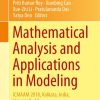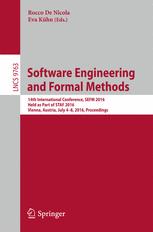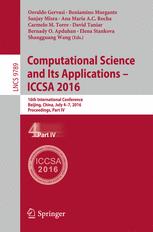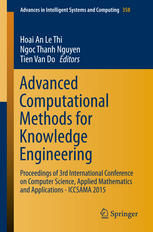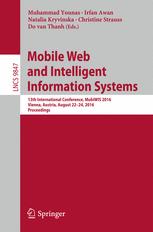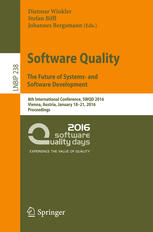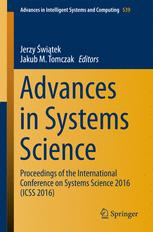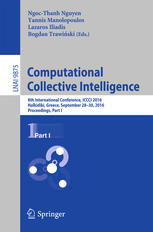Advanced Computational Methods for Knowledge Engineering Proceedings of the 4th International Conference on Computer Science Applied Mathematics and Applications ICCSAMA 2016 2 3 May 2016 Vienna Austria 1st Edition by Thanh Binh Nguyen 9783319388847 3319388843
$50.00 Original price was: $50.00.$25.00Current price is: $25.00.
Advanced Computational Methods for Knowledge Engineering Proceedings of the 4th International Conference on Computer Science Applied Mathematics and Applications ICCSAMA 2016 2 3 May 2016 Vienna Austria 1st Edition by Thanh Binh Nguyen, Tien van Do, Hoai An Le Thi, Ngoc Thanh Nguyen – Ebook PDF Instant Download/Delivery: 9783319388847, 3319388843
Full download Advanced Computational Methods for Knowledge Engineering Proceedings of the 4th International Conference on Computer Science Applied Mathematics and Applications ICCSAMA 2016 2 3 May 2016 Vienna Austria 1st Edition after payment
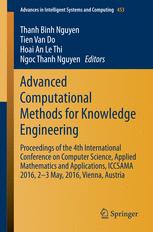
Product details:
• ISBN 10:3319388843
• ISBN 13:9783319388847
• Author:Thanh Binh Nguyen, Tien van Do, Hoai An Le Thi, Ngoc Thanh Nguyen
Advanced Computational Methods for Knowledge Engineering
Proceedings of the 4th International Conference on Computer Science, Applied Mathematics and Applications, ICCSAMA 2016, 2-3 May, 2016, Vienna, Austria
This proceedings consists of 20 papers which have been selected and invited from the submissions to the 4th International Conference on Computer Science, Applied Mathematics and Applications (ICCSAMA 2016) held on 2-3 May, 2016 in Laxenburg, Austria. The conference is organized into 5 sessions: Advanced Optimization Methods and Their Applications, Models for ICT applications,Topics on discrete mathematics, Data Analytic Methods and Applications and Feature Extractio, respectively. All chapters in the book discuss theoretical and practical issues connected with computational methods and optimization methods for knowledge engineering. The editors hope that this volume can be useful for graduate and Ph.D. students and researchers in Applied Sciences, Computer Science and Applied Mathematics.
Advanced Computational Methods for Knowledge Engineering Proceedings of the 4th International Conference on Computer Science Applied Mathematics and Applications ICCSAMA 2016 2 3 May 2016 Vienna Austria 1st Table of contents:
Part I Advanced Optimization Methodsand Their Applications
1 A DC Programming Approach to the Continuous Equilibrium Network Design Problem
1 Introduction
2 Problem Formulation
3 Solution Method by DC Programming and DCA
3.1 Introduction to DC Programming and DCA
3.2 DCA for Solving the Problem (MPCC)
4 Numerical Results
5 Conclusions
References
2 A Method for Reducing the Number of Support Vectors in Fuzzy Support Vector Machine
1 Introduction
2 Two Classes Fuzzy Support Vector Machine
3 FSVM with l0 Regularization
4 An Overview of DC Programming and DCA
5 DC Formulation and DCA for Problem (11)
6 Numerical Experiment
7 Conclusion
References
3 DC Programming and DCA for Transmit Beamforming and Power Allocation in Multicasting Relay Network
1 Introduction and Related Works
2 Transmit Beamforming and Power Allocation in Multicasting Relay Networks
3 Solution Methods by DC Programming and DCA
3.1 A Brief Overview of DC Programming and DCA
3.2 DC Programming and DCA for the Problem (10)
4 Experimental Results
4.1 Simulated Datasets and Parameter Setting
4.2 Numerical Results and Comments
5 Conclusions
References
4 Solving an Infinite-Horizon Discounted Markov Decision Process by DC Programming and DCA
1 Introduction
2 Optimization Formulations of Optimal Bellman Residual Problems
3 Solution Methods by DC Programming and DCA
3.1 Introduction of DC Programming and DCA
3.2 The ellp-norm Formulation of OBR Is a DC Program
3.3 DCA for Solving the ell1-norm Problem (11)
4 Numerical Experiments
5 Conclusion
References
Part II Models for ICT Applications
5 A Method for Transforming TimeER Model-Based Specification into Temporal XML
Abstract
1 Introduction
2 An Overview of the TimeER Model and Temporal Schema
2.1 TimeER Model
2.2 Temporal XML Schema
3 Transformation of TimeER Model into Temporal XML Schema
3.1 The Transformation Rules
3.2 Example
4 Conclusion
References
6 Job Scheduling in a Computational Cluster with Multicore Processors
1 Introduction
2 System Model and Scheduling Scenarios
2.1 System Model
2.2 Job Distribution Scenarios
2.3 Notations
3 Numerical Results
3.1 Server Specifications
3.2 Obtained Results
4 Conclusion
References
7 Modeling Multidimensional Data Cubes Based on MDA (Model-Driven Architecture)
Abstract
1 Introduction
2 Related Work
3 Multi Dimensional Conceptual Model
3.1 Motivating Example
3.2 Multidimensional Model
3.2.1 The Modeling of Dimensions
3.2.2 The Modeling of Facts
3.2.3 Dimension Constraints
4 Modeling Multidimensional Data Cubes Based on MDA
4.1 AndroMDA Concepts
4.2 Architecture of MDA-Based and Ontology-Based Framework
5 Conclusion and Future Works
References
8 Time Series Methods for Synthetic Video Traffic
Abstract
1 Introduction
2 Generation of Synthetic Video Traffic
2.1 FARIMA Models with Non Normal Errors
2.2 Approximating the Marginal Distribution of the Data
3 Performance Evaluation Analysis
4 Modeling of Real Traces
5 Conclusions
References
Part III Topics on Discrete Mathematics
9 A Constraint Solver for Equations over Sequences and Contexts
1 Introduction
2 The Language
3 Semantics
4 Solved and Partially Solved Constraints
5 Solver
5.1 Logical Rules
5.2 Failure Rules
5.3 Deletion Rules
5.4 Decomposition Rules
5.5 Variable Elimination Rules
6 Properties of the Constraint Solver
7 Well-Moded Constraints
References
10 Hyperpath Centers
1 Introduction
2 Preliminaries
3 Central Hyperpaths
3.1 Application to a 2D Spatial Data Set
4 Conclusions
References
Part IV �Data Analytic Methods and Applications
11 Analysis Techniques for Feedback-Based Educational Systems for Programming
Abstract
1 Introduction
2 Analysis Techniques for Feedback-Based Educational Systems for Programming
2.1 Programming-Specific Approaches
2.1.1 Library of Plans and Bugs
2.1.2 Program Transformation
2.1.3 Weighted Constraint-Based Model
2.1.4 Strategy-Based Model Tracing
2.2 Domain-Independent Analysis Approaches
2.2.1 Model-Tracing
2.2.2 Analysis Using Machine Learning
2.2.3 Data-Driven Approach
3 Discussion
4 Conclusion
References
12 Exploring Drivers of Urban Expansion
1 Introduction
2 Study Area
2.1 Land Use Maps
2.2 Economic Data
3 Modeling
3.1 Implementation
3.2 Pre-processing of the GIS-based Explanatory Variables
3.3 Principal Component Analysis
3.4 Data Compilation
4 Results
4.1 Results of Multiple Regression
4.2 Discussion
5 Conclusion
References
The Cropland Capture Game: Good Annotators Versus Vote Aggregation Methods
1 Introduction
2 Related Work
3 Data
4 Methodology
4.1 Detection of Duplicates and Blurry Images
4.2 Majority Voting Based on Reliability
5 Benchmark
5.1 Annotator Models
6 Discussion
References
14 The Formal Models for the Socratic Method
Abstract
1 Introduction
2 State of the Art of Computer Modeling of Critical Thinking
2.1 The Socratic Method
2.2 Applications that Support the Socratic Method
3 The Formal Models of the Socratic Method
4 Implementation
5 A Case Study: A Socratic Group Discussion Application
6 Conclusions and Future Work
References
15 Using Local Weather and Geographical Information to Predict Cholera Outbreaks in Hanoi, Vietnam
1 Introduction
2 Related Works
3 Description of the Study Area and Data Sets
3.1 Study Area
3.2 Geographical Data Sets
3.3 Cholera Data Set
3.4 Local Weather Data Set
3.5 SOI Data Set
4 Features Selection and Models Building
4.1 Features Selection
4.2 Models Building
5 Prediction Results Analysis
5.1 Effects of Weather Predictors and Geographical Predictors to the Accuracy of Prediction
5.2 Relationship of Prediction Accuracy and Prediction Length
5.3 Importance of Weather Variables
6 Conclusions
References
Part V Feature Extraction
16 Effect of the Text Size on Stylometry—Application on Arabic Religious Texts
Abstract
1 Introduction and Related Work
2 Dataset
3 Authorship Attribution Methodology
3.1 General Algorithm
3.2 Conventional Classifiers
4 Authorship Attribution Experiments
4.1 Authorship Attribution Using Character Penta-Grams
4.2 Authorship Attribution Using Words
4.3 Robustness Against Size Reduction Ratio: RSR
5 Application of Authorship Attribution on Religious Books
5.1 Experiments of Authorship Attribution Using Conventional Classifiers
5.2 Experiments of Authorship Attribution Using Fusion Techniques
5.3 Comments
6 Conclusion
Acknowledgements
References
17 Personalized Facets for Faceted Search Using Wikipedia Disambiguation and Social Network
Abstract
1 Introduction
2 Related Works
3 Personalized Facets for Faceted Search Using Wikipedia Disambiguation and Social Network
3.1 Phase 1: Data Preparation
3.2 Phase 2: Prepare User Profile
3.3 Phase 3: Search Visualization
4 Experiment
4.1 Disambiguation Extraction Evaluation
4.2 Search Result Evaluation
4.2.1 Personalization Evaluation
4.2.2 Accuracy Evaluation
4.2.3 Filtering Evaluation
4.3 Vertices Size Effectiveness
5 Conclusions
References
18 Readiness Measurement Model (RMM): Mathematical-Based Evaluation Technique for the Quantification
Abstract
1 Introduction
2 Methods and Materials
2.1 Scale Development
2.2 Weightage Extraction
2.3 Code Specificity
2.4 Optimisation of Parameters
2.5 Readiness Measurement Model (RMM)
3 Case Study and Results
4 Conclusion
References
19 Triple Extraction Using Lexical Pattern-based Syntax Model
Abstract
1 Introduction
2 Related Works
3 Triple Extraction Using Lexical Pattern-based Syntax Model
3.1 Observation
3.2 New Triple Extraction Algorithm
4 Experimental Result Comparison
4.1 Good Points
4.2 Weak Points
5 Conclusion
References
20 Using Mathematical Tools to Reduce the Combinatorial Explosion During the Automatic Segmentation
Abstract
1 Introduction
2 Identifications of the Musical Motif
3 Segmentation and Combinatorial Explosion
4 Reduction of the Combinatorial Explosion
5 The Obtained Results
6 Conclusions and Future Work
References
Author Index
People also search for Advanced Computational Methods for Knowledge Engineering Proceedings of the 4th International Conference on Computer Science Applied Mathematics and Applications ICCSAMA 2016 2 3 May 2016 Vienna Austria 1st:
advanced computational methods
advanced computational methods in civil engineering
advanced computational methods in mechanical and materials engineering
advanced computational methods for knowledge engineering
advanced computational methods and geomechanics
You may also like…
Computers - Computer Science
Science (General) - International Conferences and Symposiums


